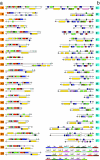The Orientia tsutsugamushi genome reveals massive proliferation of conjugative type IV secretion system and host-cell interaction genes
- PMID: 17483455
- PMCID: PMC1876558
- DOI: 10.1073/pnas.0611553104
The Orientia tsutsugamushi genome reveals massive proliferation of conjugative type IV secretion system and host-cell interaction genes
Abstract
Scrub typhus is caused by the obligate intracellular rickettsia Orientia tsutsugamushi (previously called Rickettsia tsutsugamushi). The bacterium is maternally inherited in trombicuid mites and transmitted to humans by feeding larvae. We report here the 2,127,051-bp genome of the Boryong strain, which represents the most highly repeated bacterial genome sequenced to date. The repeat density of the scrub typhus pathogen is 200-fold higher than that of its close relative Rickettsia prowazekii, the agent of epidemic typhus. A total of 359 tra genes for components of conjugative type IV secretion systems were identified at 79 sites in the genome. Associated with these are >200 genes for signaling and host-cell interaction proteins, such as histidine kinases, ankyrin-repeat proteins, and tetratrico peptide-repeat proteins. Additionally, the O. tsutsugamushi genome contains >400 transposases, 60 phage integrases, and 70 reverse transcriptases. Deletions and rearrangements have yielded unique gene combinations as well as frequent pseudogenization in the tra clusters. A comparative analysis of the tra clusters within the genome and across strains indicates sequence homogenization by gene conversion, whereas complexity, diversity, and pseudogenization are acquired by duplications, deletions, and transposon integrations into the amplified segments. The results suggest intragenomic duplications or multiple integrations of a massively proliferating conjugative transfer system. Diversifying selection on host-cell interaction genes along with repeated population bottlenecks may drive rare genome variants to fixation, thereby short-circuiting selection for low complexity in bacterial genomes.
Conflict of interest statement
The authors declare no conflict of interest.
Figures




Similar articles
-
The Whole-genome sequencing of the obligate intracellular bacterium Orientia tsutsugamushi revealed massive gene amplification during reductive genome evolution.DNA Res. 2008 Aug;15(4):185-99. doi: 10.1093/dnares/dsn011. Epub 2008 May 28. DNA Res. 2008. PMID: 18508905 Free PMC article.
-
Long-read whole genome sequencing and comparative analysis of six strains of the human pathogen Orientia tsutsugamushi.PLoS Negl Trop Dis. 2018 Jun 6;12(6):e0006566. doi: 10.1371/journal.pntd.0006566. eCollection 2018 Jun. PLoS Negl Trop Dis. 2018. PMID: 29874223 Free PMC article.
-
Orientia tsutsugamushi Strain Ikeda Ankyrin Repeat-Containing Proteins Recruit SCF1 Ubiquitin Ligase Machinery via Poxvirus-Like F-Box Motifs.J Bacteriol. 2015 Oct;197(19):3097-109. doi: 10.1128/JB.00276-15. Epub 2015 Jul 13. J Bacteriol. 2015. PMID: 26170417 Free PMC article.
-
New perspectives on rickettsial evolution from new genome sequences of rickettsia, particularly R. canadensis, and Orientia tsutsugamushi.Ann N Y Acad Sci. 2005 Dec;1063:47-63. doi: 10.1196/annals.1355.006. Ann N Y Acad Sci. 2005. PMID: 16481489 Review.
-
Orientia tsutsugamushi: An Unusual Intracellular Bacteria-Adaptation Strategies, Available Antibiotics, and Alternatives for Treatment.Curr Microbiol. 2024 Jun 21;81(8):236. doi: 10.1007/s00284-024-03754-1. Curr Microbiol. 2024. PMID: 38907107 Review.
Cited by
-
Spatiotemporal Dynamics of Scrub Typhus Transmission in Mainland China, 2006-2014.PLoS Negl Trop Dis. 2016 Aug 1;10(8):e0004875. doi: 10.1371/journal.pntd.0004875. eCollection 2016 Aug. PLoS Negl Trop Dis. 2016. PMID: 27479297 Free PMC article.
-
Characterization of a newly discovered symbiont of the whitefly Bemisia tabaci (Hemiptera: Aleyrodidae).Appl Environ Microbiol. 2013 Jan;79(2):569-75. doi: 10.1128/AEM.03030-12. Epub 2012 Nov 9. Appl Environ Microbiol. 2013. PMID: 23144129 Free PMC article.
-
Local hopping mobile DNA implicated in pseudogene formation and reductive evolution in an obligate cyanobacteria-plant symbiosis.BMC Genomics. 2015 Mar 17;16(1):193. doi: 10.1186/s12864-015-1386-7. BMC Genomics. 2015. PMID: 25885210 Free PMC article.
-
Intracellular invasion by Orientia tsutsugamushi is mediated by integrin signaling and actin cytoskeleton rearrangements.Infect Immun. 2010 May;78(5):1915-23. doi: 10.1128/IAI.01316-09. Epub 2010 Feb 16. Infect Immun. 2010. PMID: 20160019 Free PMC article.
-
Detection and distribution of Sca autotransporter protein antigens in diverse isolates of Orientia tsutsugamushi.PLoS Negl Trop Dis. 2018 Sep 20;12(9):e0006784. doi: 10.1371/journal.pntd.0006784. eCollection 2018 Sep. PLoS Negl Trop Dis. 2018. PMID: 30235210 Free PMC article.
References
Publication types
MeSH terms
Substances
LinkOut - more resources
Full Text Sources
Other Literature Sources
Molecular Biology Databases

